26 March 1778 Thursday
Vases, Candelabra, Grave Stones, Sarcophagi. Tripods, Lamps and Ancient Ornaments volume II
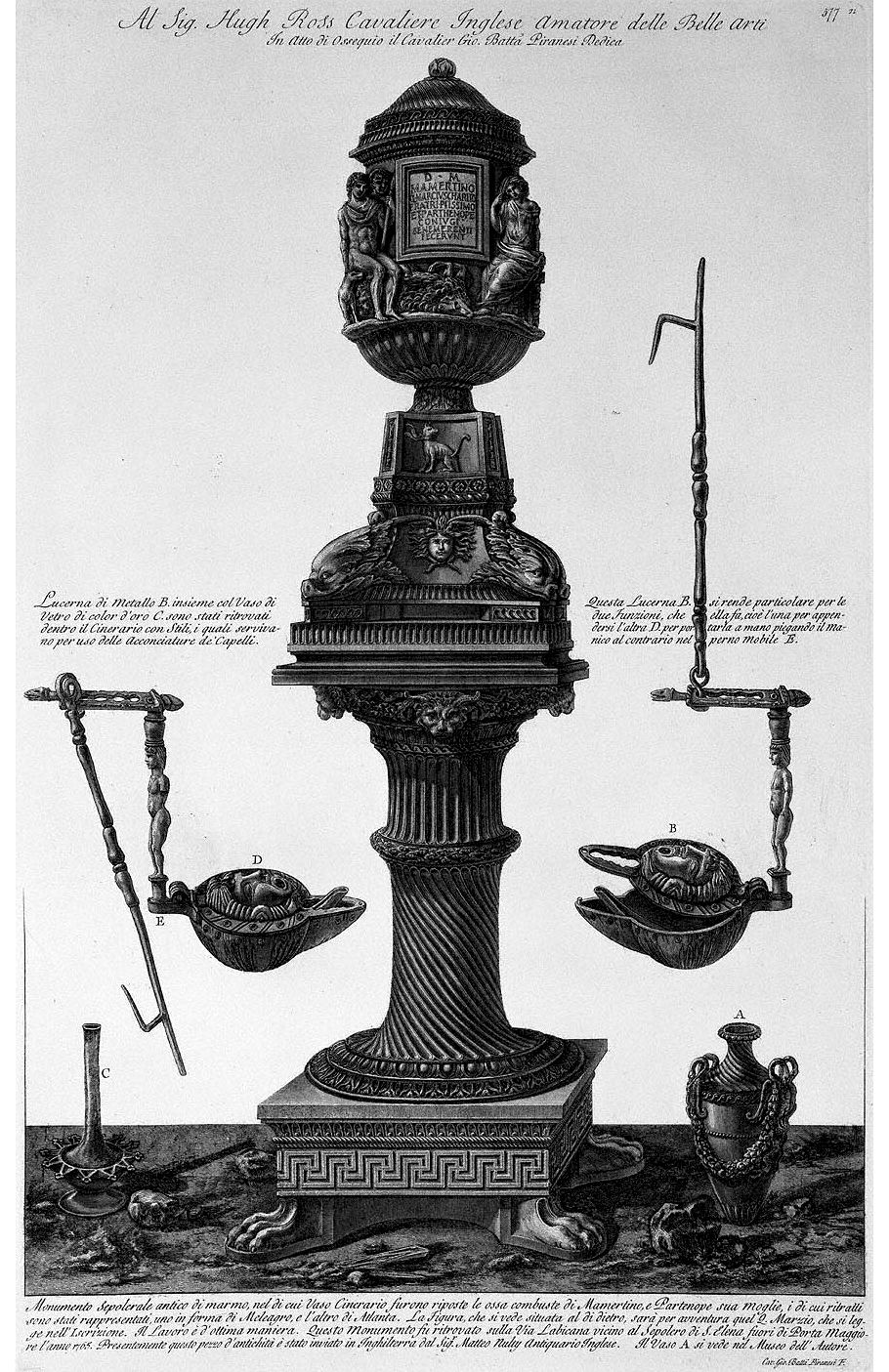
To Mr. Hugh Ross English Knight Lover of the Fine Arts
In Act of Obsequiousness Cavalier Gio. Batt(ist) to Piranesi Dedicates
Lamp of Metal B. together with the Vase of Glass of gold color C. were found inside the Cinerary with Styles, which were used for the use of Hairstyles.
This Lamp B. is particular for the two Functions it performs, namely one for hanging the other D. for carrying it by hand by bending the Handle backwards into the Mobile pin E.
Ancient sepulchral monument of marble, in whose cinerary vase the burnt bones of Mamertino and Partenope his wife were placed, whose portraits have been represented, one in the form of Meleager, and the other of Atlanta. The Figure, which can be seen located behind, will by chance be that Q. Marzio, which can be read in the Inscription. The Work is excellent. This Monument was found on the Via Labicana near the Sepulcher of S. Elena [Helena] outside Porta Maggiore in the year 1765. At present this piece of antiquity was sent to England by Mr. Matteo Nulty English antiquarian. Vase A can be seen in the Author's Museum.
Cav. Gio. Batt(ist)a Piranesi F.
24-25 y.o. Francesco Piranesi 1783
The Tomb of Mamia in Pompeii
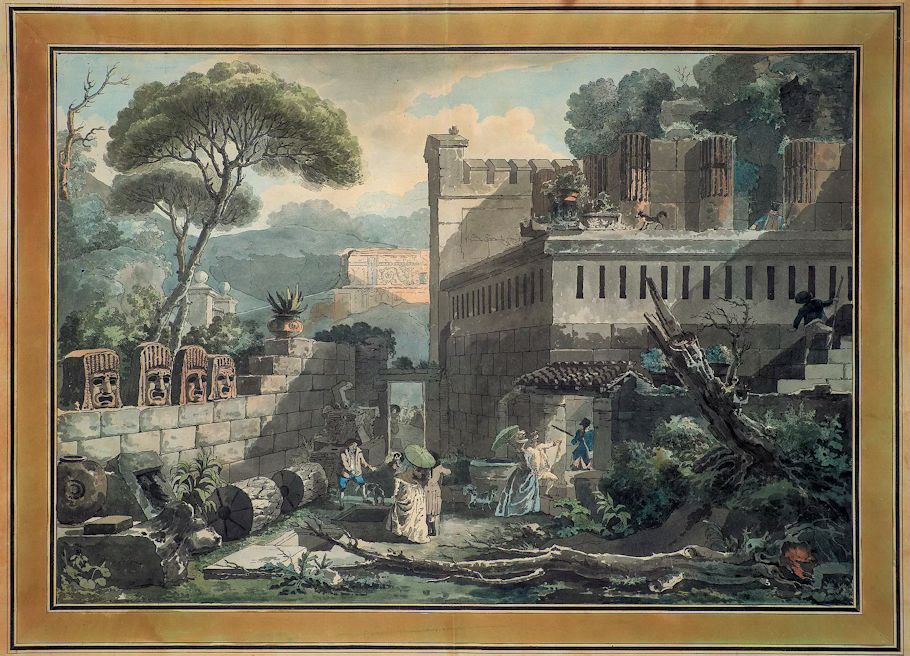
Etching, reworked with water colour and gouache, the image surrounded by an engraved paper mat. 47.9 x 69.3 cm. Signed “despres” with pen and brown ink at the lower left of the image; on the paper mat signed and titled by the artist in pen and brown ink “Desprez” respectively “Tombeau de Mamia à P…” (signature and title faded); annotated at the lower right by Francesco Piranesi “se vend chez Mr. François Piranesi à Rome”; verso numbered “N° 3” in pen and brown ink.
45-46 y.o. Francesco Piranesi 1804
Calcography of the Piranesis
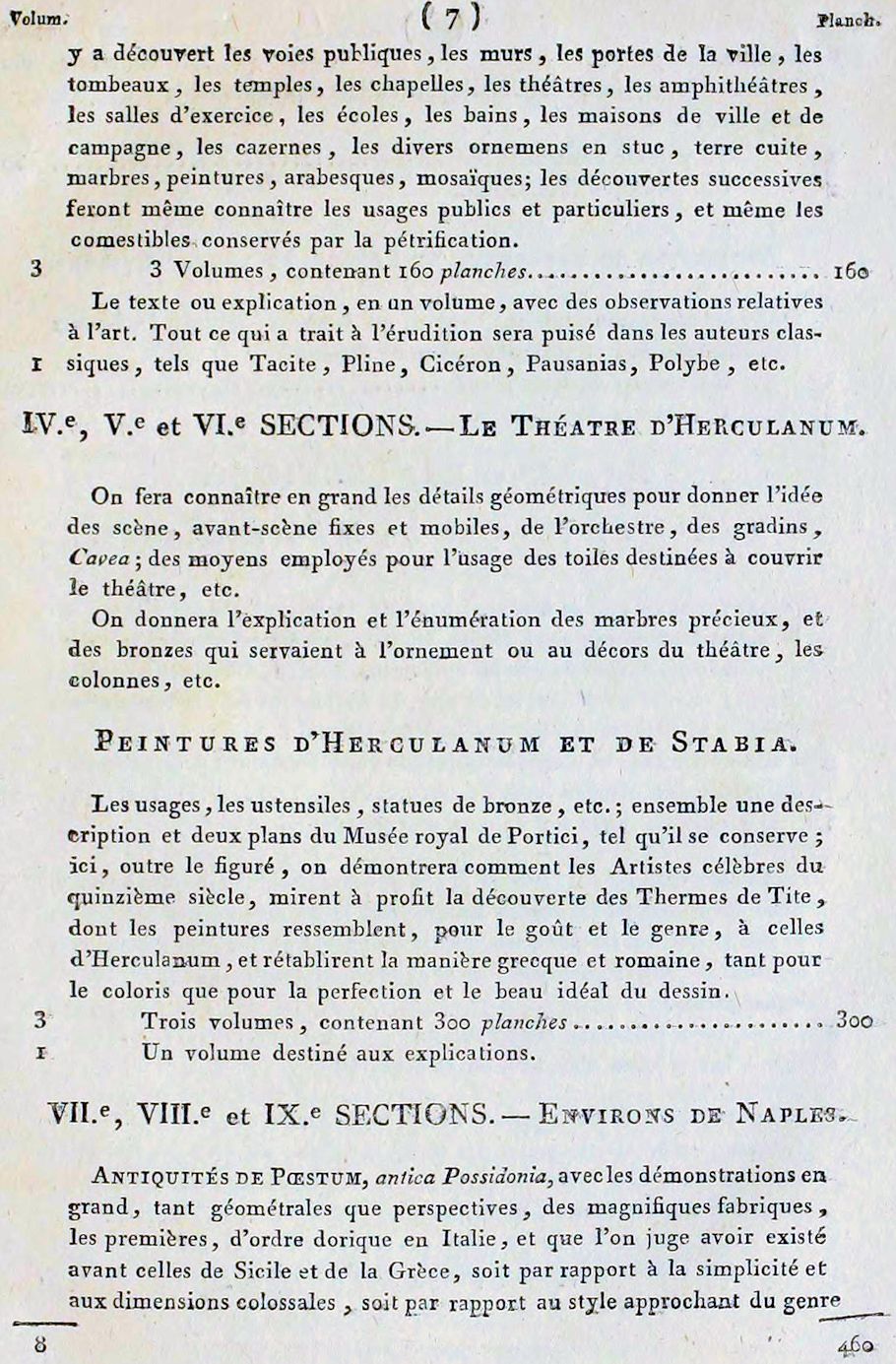
Pompeia, famous city, buried in its entirety in the seventy-ninth year of the Christian era, the only city to emerge from its rubble: public roads, walls, city gates, tombs, temples, chapels, theatres, amphitheatres, exercise halls, schools, baths, townhouses and countryside, the cazernes, the various ornaments in stucco, terracotta, marble, paintings, arabesques, mosaics; successive discoveries will even make known the public and private uses, and even the foodstuffs preserved by petrification.
Three volumes, containing 160 plates
The text or explanation, in one volume, with observations relating to art. Everything relating to erudition will be drawn from classical authors, such as Tacitus, Pliny, Cicero, Pausanias, Polybius, etc.
4th, 5th & 6th DIVISIONS - The Theater of Herculaneum.
The geometric details will be widely known to give the idea of ??the stage, fixed and mobile fore-stages, the orchestra, the bleachers, Cavea; the means employed for the use of the canvases intended to cover the theatre, etc.
We will give the explanation and the enumeration of the precious marbles, and the bronzes which were used for the ornament or the decorations of the theater, the columns, etc.
Paintings from Herculaneum and Stabia.
Uses, utensils, bronze statues, etc.; together a description and two plans of the Royal Museum of Portici, as it is preserved; here, in addition to the figurative, we will demonstrate how the famous artists of the fifteenth century took advantage of the discovery of the Baths of Titus, whose paintings resemble, in taste and genre, those of Herculianum, and reestablished the Greek and Roman manner, as much for the coloring as for the perfection and the beautiful ideal of the design.
Three volumes, containing 300 plates
A volume intended for explanations.
7th, 8th & 9th DIVISIONS - Surroundings of Naples
Antiquities of Pœstum, antica Possidonia, with demonstrations on a large scale, both geometrical and perspective, of the magnificent structures, the first, of the Doric order in Italy, and which are judged to have existed before those of Sicily and Greece, either by in relation to the simplicity and the colossal dimensions, or in relation to the style approaching the Tuscan genre. We will add particular details to the walls of the city, to the sculpture, etc.
Three volumes, containing 50 plates
A volume of explanation.
26 March 1812 Thursday

Morning hazy, wind SW Serly. Therm. 36°. Roads to Meeting dusty. My bees are out as lively as in May. Therm. rose to 64+.
26 March 2002
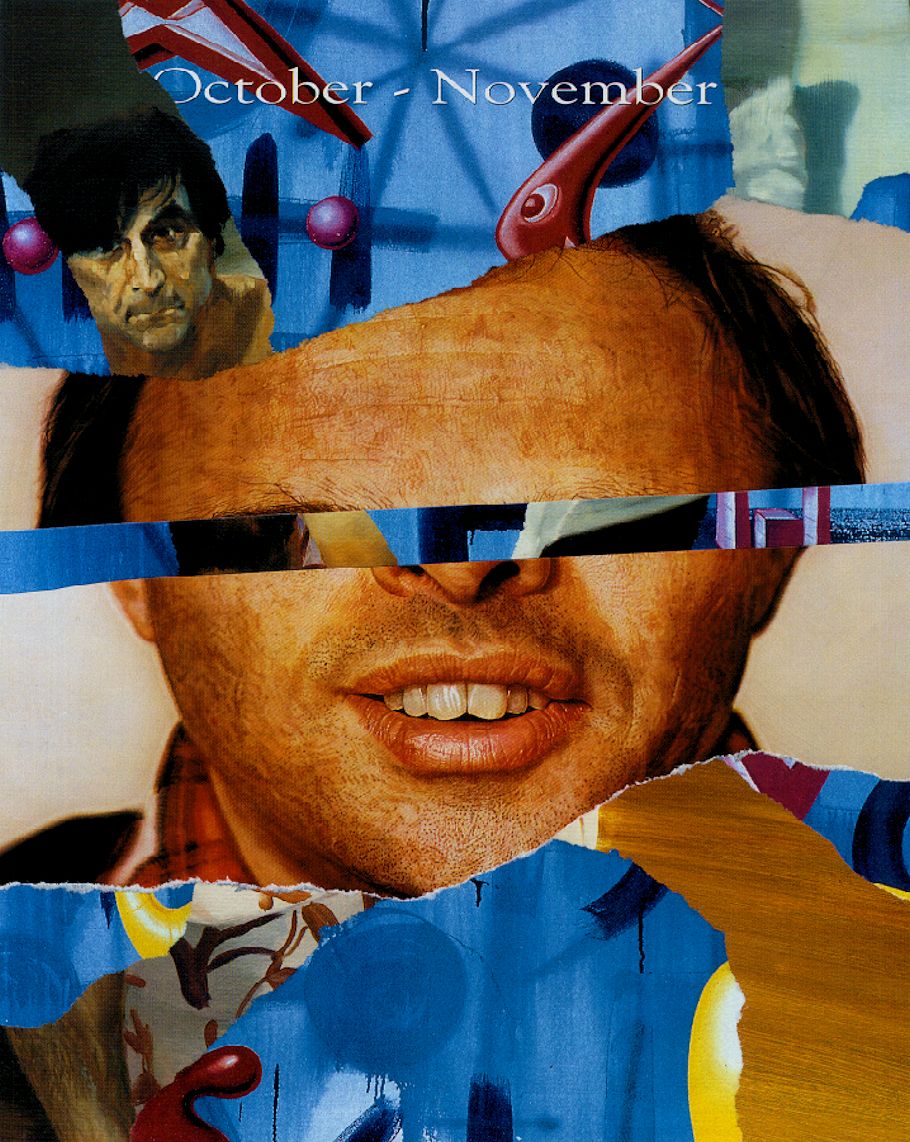
October - November
26 March 2004
Re: The history of the destruction of architecture
Imagine how different ancient architectural history would be if there were existing records of all the 'Pagan' temples destroyed in the name of Christianity. For example, where exactly in Greece did the spiral columns within the original St. Peter's Basilica (later reenacted via the baldachin by Bernini) come from? It was Eutropia that first told Helena about these columns and their original location.
Or what would architectural history be like if all the buildings that were ever erected on this planet were a matter of record?
[For example:]
Chapter 54. Destruction of Idol Temples and Images everywhere.
All these things the emperor diligently performed to the praise of the saving power of Christ, and thus made it his constant aim to glorify his Saviour God. On the other hand he used every means to rebuke the superstitious errors of the heathen. Hence the entrances of their temples in the several cities were left exposed to the weather, being stripped of their doors at his command; the tiling of others was removed, and their roofs destroyed. From others again the venerable statues of brass, of which the superstition of antiquity had boasted for a long series of years, were exposed to view in all the public places of the imperial city: so that here a Pythian, there a Sminthian Apollo, excited the contempt of the beholder: while the Delphic tripods were deposited in the hippodrome and the Muses of Helicon in the palace itself. In short, the city which bore his name was everywhere filled with brazen statues of the most exquisite workmanship, which had been dedicated in every province, and which the deluded victims of superstition had long vainly honored as gods with numberless victims and burnt sacrifices, though now at length they learned to renounce their error, when the emperor held up the very objects of their worship to be the ridicule and sport of all beholders. With regard to those images which were of gold, he dealt with them in a different manner. For as soon as he understood that the ignorant multitudes were inspired with a vain and childish dread of these bugbears of error, wrought in gold and silver, he judged it right to remove these also, like stumbling-stones thrown in the way of men walking in the dark, and henceforward to open a royal road, plain and unobstructed to all. Having formed this resolution, he considered no soldiers or military force of any sort needful for the suppression of the evil: a few of his own friends sufficed for this service, and these he sent by a simple expression of his will to visit each several province. Accordingly, sustained by confidence in the emperor's pious intentions and their own personal devotion to God, they passed through the midst of numberless tribes and nations, abolishing this ancient error in every city and country. They ordered the priests themselves, amidst general laughter and scorn, to bring their gods from their dark recesses to the light of day: they then stripped them of their ornaments, and exhibited to the gaze of all the unsightly reality which had been hidden beneath a painted exterior. Lastly, whatever part of the material appeared valuable they scraped off and melted in the fire to prove its worth, after which they secured and set apart whatever they judged needful for their purpose, leaving to the superstitious worshipers that which was altogether useless, as a memorial of their shame. Meanwhile our admirable prince was himself engaged in a work similar to what we have described. For at the same time that these costly images of the dead were stripped, as we have said, of their precious materials, he also attacked those composed of brass; causing those to be dragged from their places with ropes and as it were carried away captive, whom the dotage of mythology had esteemed as gods.
Chapter 55. Overthrow of an Idol Temple, and Abolition of Licentious Practices, at Aphaca in Phœnicia.
The emperor's next care was to kindle, as it were, a brilliant torch, by the light of which he directed his imperial gaze around, to see if any hidden vestiges of error might still exist. And as the keen-sighted eagle in its heavenward flight is able to descry from its lofty height the most distant objects on the earth, so did he, while residing in the imperial palace of his own fair city, discover as from a watchtower a hidden and fatal snare of souls in the province of Phœnicia. This was a grove and temple, not situated in the midst of any city, nor in any public place, as for splendor of effect is generally the case, but apart from the beaten and frequented road, at Aphaca, on part of the summit of Mount Lebanon, and dedicated to the foul demon known by the name of Venus. It was a school of wickedness for all the votaries of impurity, and such as destroyed their bodies with effeminacy. Here men undeserving of the name forgot the dignity of their sex, and propitiated the demon by their effeminate conduct; here too unlawful commerce of women and adulterous intercourse, with other horrible and infamous practices, were perpetrated in this temple as in a place beyond the scope and restraint of law. Meantime these evils remained unchecked by the presence of any observer, since no one of fair character ventured to visit such scenes. These proceedings, however, could not escape the vigilance of our august emperor, who, having himself inspected them with characteristic forethought, and judging that such a temple was unfit for the light of heaven, gave orders that the building with its offerings should be utterly destroyed. Accordingly, in obedience to the imperial command, these engines of an impure superstition were immediately abolished, and the hand of military force was made instrumental in purging the place. And now those who had heretofore lived without restraint learned self-control through the emperor's threat of punishment, as likewise those superstitious Gentiles wise in their own conceit, who now obtained experimental proof of their own folly.
Chapter 56. Destruction of the Temple of Æsculapius at Ægæ.
For since a wide-spread error of these pretenders to wisdom concerned the demon worshipped in Cilicia, whom thousands regarded with reverence as the possessor of saving and healing power, who sometimes appeared to those who passed the night in his temple, sometimes restored the diseased to health, though on the contrary he was a destroyer of souls, who drew his easily deluded worshipers from the true Saviour to involve them in impious error, the emperor, consistently with his practice, and desire to advance the worship of him who is at once a jealous God and the true Saviour, gave directions that this temple also should be razed to the ground. In prompt obedience to this command, a band of soldiers laid this building, the admiration of noble philosophers, prostrate in the dust, together with its unseen inmate, neither demon nor god, but rather a deceiver of souls, who had seduced mankind for so long a time through various ages. And thus he who had promised to others deliverance from misfortune and distress, could find no means for his own security, any more than when, as is told in myth, he was scorched by the lightning's stroke. Our emperor's pious deeds, however, had in them nothing fabulous or feigned; but by virtue of the manifested power of his Saviour, this temple as well as others was so utterly overthrown, that not a vestige of the former follies was left behind.
Chapter 57. How the Gentiles abandoned Idol Worship, and turned to the Knowledge of God.
Hence it was that, of those who had been the slaves of superstition, when they saw with their own eyes the exposure of their delusion, and beheld the actual ruin of the temples and images in every place, some applied themselves to the saving doctrine of Christ; while others, though they declined to take this step, yet reprobated the folly which they had received from their fathers, and laughed to scorn what they had so long been accustomed to regard as gods. Indeed, what other feelings could possess their minds, when they witnessed the thorough uncleanness concealed beneath the fair exterior of the objects of their worship? Beneath this were found either the bones of dead men or dry skulls, fraudulently adorned by the arts of magicians, or filthy rags full of abominable impurity, or a bundle of hay or stubble. On seeing all these things heaped together within their lifeless images, they denounced their fathers' extreme folly and their own, especially when neither in the secret recesses of the temples nor in the statues themselves could any inmate be found; neither demon, nor utterer of oracles, neither god nor prophet, as they had heretofore supposed: nay, not even a dim and shadowy phantom could be seen. Accordingly, every gloomy cavern, every hidden recess, afforded easy access to the emperor's emissaries: the inaccessible and secret chambers, the innermost shrines of the temples, were trampled by the soldiers' feet; and thus the mental blindness which had prevailed for so many ages over the gentile world became clearly apparent to the eyes of all.
Chapter 58. How he destroyed the Temple of Venus at Heliopolis, and built the First Church in that City.
Such actions as I have described may well be reckoned among the emperor's noblest achievements, as also the wise arrangements which he made respecting each particular province. We may instance the Phœnician city Heliopolis, in which those who dignify licentious pleasure with a distinguishing title of honor, had permitted their wives and daughters to commit shameless fornication. But now a new statute, breathing the very spirit of modesty, proceeded from the emperor, which peremptorily forbade the continuance of former practices. And besides this he sent them also written exhortations, as though he had been especially ordained by God for this end, that he might instruct all men in the principles of chastity. Hence, he disdained not to communicate by letter even with these persons, urging them to seek diligently the knowledge of God. At the same time he followed up his words by corresponding deeds, and erected even in this city a church of great size and magnificence: so that an event unheard of before in any age, now for the first time came to pass, namely, that a city which had hitherto been wholly given up to superstition now obtained the privilege of a church of God, with presbyters and deacons, and its people were placed under the presiding care of a bishop consecrated to the service of the supreme God. And further, the emperor, being anxious that here also as many as possible might be won to the truth, bestowed abundant provision for the necessities of the poor, desiring even thus to invite them to seek the doctrines of salvation, as though he were almost adopting the words of him who said, "Whether in pretense, or in truth, let Christ be preached,"
Eusebius of Caeserea Life of Constantine Book III 339 CE
Re: NYC Late Antique Exhibit
"A favorite game is to name all the relatives and in-laws killed by Constantine and his sons."
In my opinion, no history of Constantine is correct and/or complete without mention and analysis of the law of silence he imposed regarding Helena and her finding of the True Cross 25 July 326, just hours after Helena's death at Naples.
26 March 2007
Theory Part II - Doing What I Said I Would Do...
...reenacting Piranesi's drawing of the Ichnographia Campus Martius became the most productive for me. And then by translating Piranesi's plan labels throughout the Ichnographia I learned Piranesi's process of the project. Again, a very productive reenactionary activity for me.
Of course "productive misreading" is different than lying. But in our crazy modern reality "productive misreading" and lying are sometimes the same thing.
26 March 2016
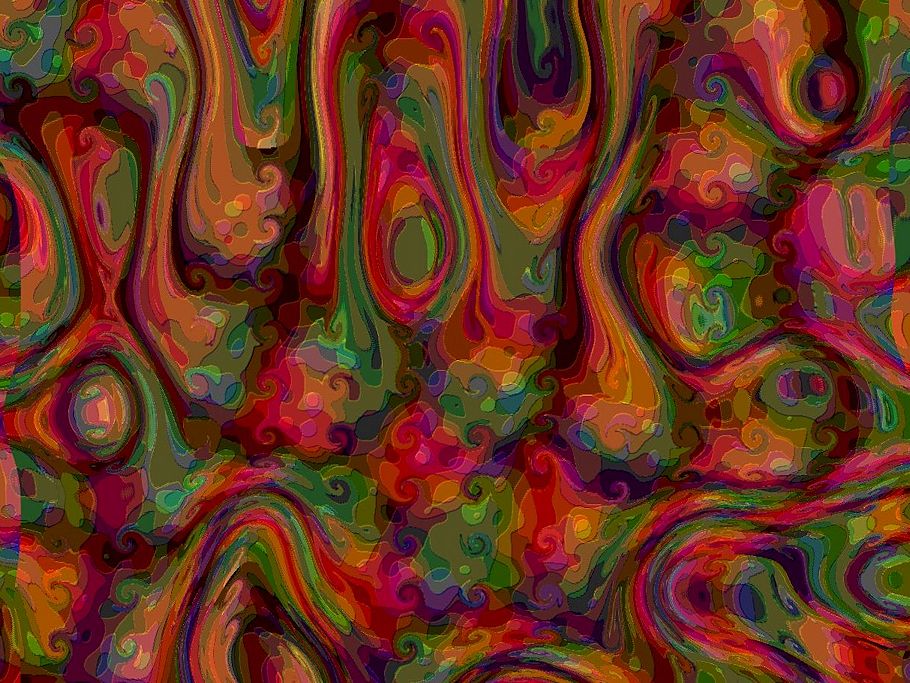
Virtual Painting 267
26 March 2023 Sunday
I now realize that making actual history, perhaps even intrinsically, comes with the task of fixing the existing history. The fixed history is the aftermath of the new history. Aftermath in the sense that new history manifests a significant unpleasant event for existing history, catastrophic, even, within the wake of the new history's epicenter.
|